Posted by: Northwest Eye in General on July 19, 2025
Overview
Eyelid surgery, also known as blepharoplasty, is an important step towards enhancing your appearance and confidence. We understand that the thought of surgery can be daunting, which is why careful preparation and adherence to post-operative care are essential for a successful recovery and optimal results.
Before the procedure, engaging in pre-operative consultations is crucial. This is your opportunity to voice any concerns and ask questions. Arranging transportation for the day of surgery is also important, as you will need support afterward. Following medication guidelines as prescribed by your doctor will aid in a smoother recovery.
During your recovery, we encourage you to take care of yourself by:
- Applying cold compresses to reduce swelling and discomfort.
- Avoiding strenuous tasks during this time.
It’s common to feel anxious about resuming normal activities, so each of these steps is aimed at minimizing complications and enhancing your healing process. Remember, we are here to help you through this journey, ensuring you feel supported every step of the way.
Introduction
Eyelid surgery, or blepharoplasty, is a transformative procedure that many individuals are turning to in their quest to rejuvenate their appearance. We understand that the journey from consultation to recovery can feel overwhelming, filled with critical steps that can significantly impact your overall outcome.
This article offers an essential checklist for you, guiding you through:
- Pre-operative preparations
- Post-operative care
- Lifestyle adjustments to ensure a smooth recovery
It’s common to wonder about the challenges that might arise during this process, and we are here to help you navigate them effectively to achieve the best results.
Prepare for Eyelid Surgery: Key Steps to Take
Prepare for Eyelid Surgery: Key Steps to Take
We understand that preparing for eyelid surgery can be a daunting experience. Here are some important steps to help you feel more at ease:
- Schedule a pre-operative consultation to discuss your medical history and any medications you are taking. This information is crucial for a safe procedure, especially for those considering the Light Adjustable Lens (LAL) procedure. Understanding your vision needs is essential.
- Arrange for a responsible individual to drive you home post-surgery. Sedation may impair your ability to operate a vehicle, and about 95 percent of patients indicate the significance of having support after eyelid surgery before and after to ensure a safe recovery.
- Follow your surgeon’s instructions regarding medication modifications, particularly concerning blood thinners. This helps reduce risks during the procedure.
- It’s common to feel anxious about the impact of lifestyle choices. Avoid smoking and alcohol intake for at least fourteen days before the surgery to promote ideal recovery.
- Prepare your home for healing by creating a comfortable resting area stocked with essential supplies, such as ice packs and prescribed medications. This will help you feel more secure as you recover.
- Ensure you have sufficient time away from work and other activities—generally allowing one to two weeks for healing will help guarantee a smooth process.
- Engage in open discussions with your surgeon about any concerns or questions you may have. This fosters confidence and clarity as you approach the procedure. Additionally, understanding potential causes of blurred vision, such as cataracts, can help you set realistic expectations for your recovery and vision outcomes.
We are here to help you through this process, ensuring you .
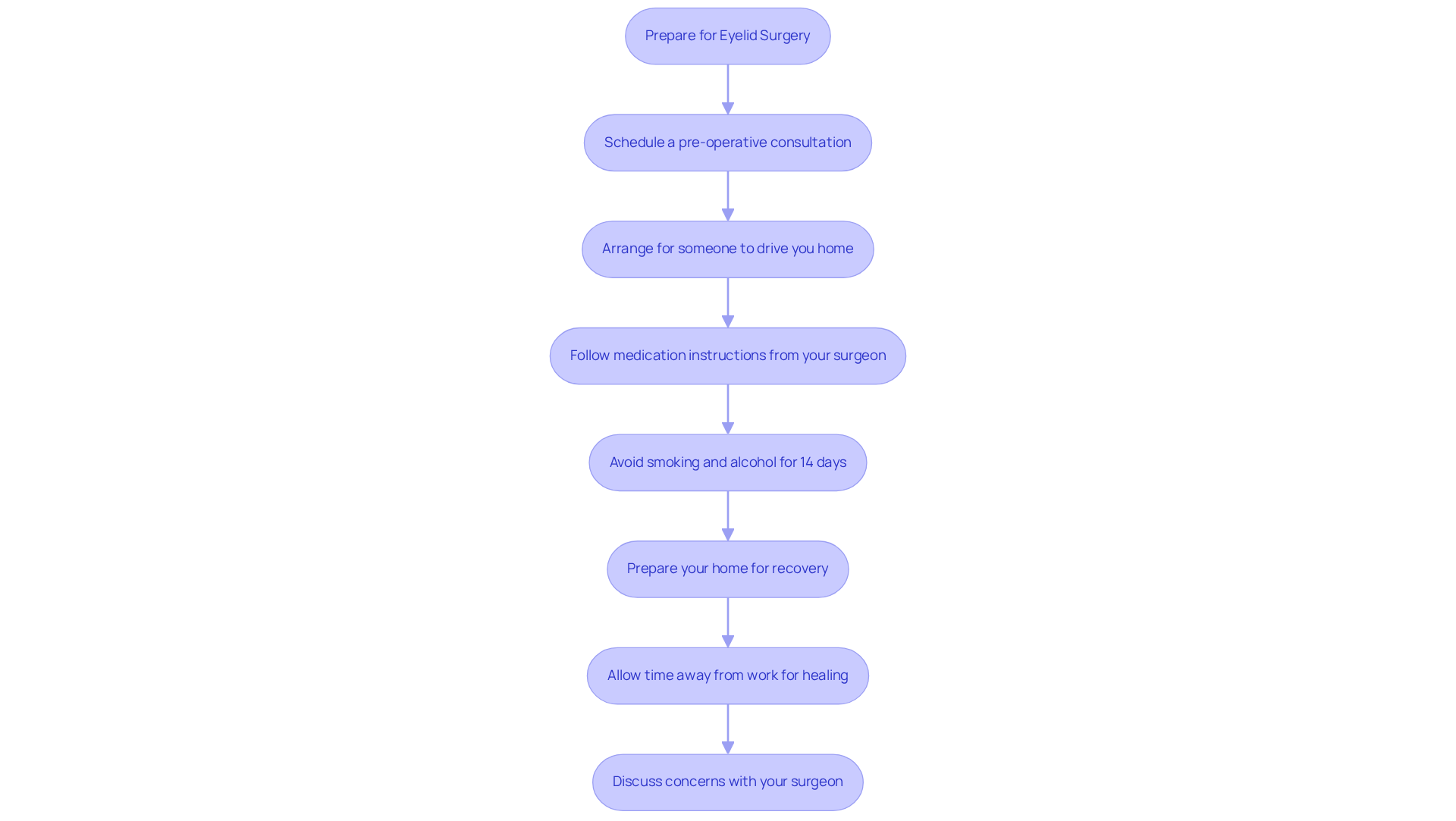
Post-Operative Care: Essential Instructions for Recovery
We understand that recovering from surgery can be challenging, and we are here to support you every step of the way. Applying cold compresses to your eyes for the first 48 hours can significantly reduce swelling and discomfort. These compresses help constrict blood vessels and . It’s common for postoperative swelling to worsen during the initial 24 to 48 hours following surgery, so managing it effectively is essential. Recovery can vary based on the exact procedure performed and the individual patient, but typical bruising and swelling of the eyelids can be observed in eyelid surgery before and after blepharoplasty. We advise you to plan on being at home for a few days during this time to focus on your healing.
Taking prescribed medications as directed, including pain relievers and antibiotics if necessary, will facilitate a smoother recovery process. Remember to keep your head elevated while resting; this position aids in fluid drainage and reduces pressure on the surgical site, further minimizing swelling. We encourage you to avoid strenuous activities, bending down, or heavy lifting for at least fourteen days to prevent heightened swelling and possible complications. Most patients find they can resume driving and moving around without much difficulty after several days.
It’s important to refrain from wearing makeup on your eyelids for at least two weeks post-surgery to allow the skin to heal properly and reduce the risk of infection. Attending all follow-up appointments is crucial for monitoring your healing and addressing any concerns, ensuring that your progress remains on track. If you notice any unusual symptoms, such as excessive swelling, bleeding, or vision changes, please report them to your surgeon immediately. Prompt intervention can help prevent complications. Remember, each patient’s recovery experience is unique, and it’s vital to have realistic expectations about the healing process.
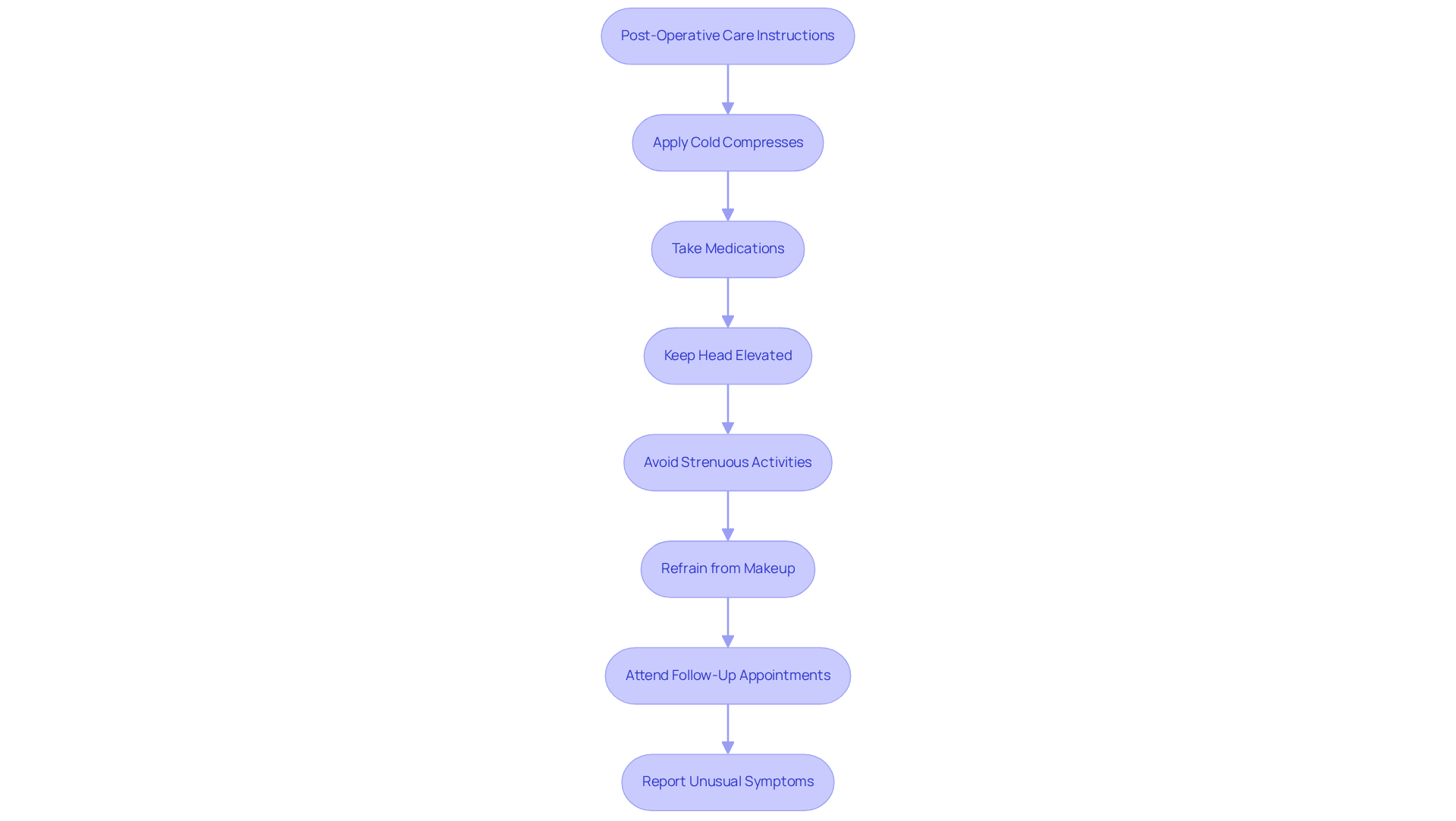
Address Common Concerns: FAQs About Recovery and Results
Swelling and bruising are common after blepharoplasty, often peaking within the first few days. We understand that this can be concerning, but most patients notice gradual improvement over the following fourteen days, especially with proper care such as cold compresses. It’s advisable to plan on staying home for a few days, as frequent icing applied to the eyelids will significantly help reduce bruising and swelling.
Typically, patients can resume light activities within seven days, with many returning to their usual routines in about 10-14 days. However, complete recovery may take several weeks. After a few days, most patients find they can operate a vehicle and move about comfortably, but it’s essential to avoid heavy lifting and intense exercise for two weeks following the procedure.
Scarring is usually minimal, as surgeons strategically place incisions in the natural folds of the eye to enhance concealment. With time, these scars tend to . It’s important to remember that the final results of eyelid surgery before and after can take several months to fully appear, as swelling subsides and tissues heal. Patience is key during this time, and we are here to support you.
To ensure a smooth recovery, it’s crucial to avoid sun exposure, swimming, and intense activities that increase blood flow to the eyes for the first two to four weeks after surgery, until your surgeon gives the green light. Additionally, stopping smoking at least six weeks prior to treatment can help prevent complications during healing. Following these guidelines will contribute to a more comfortable recovery process.
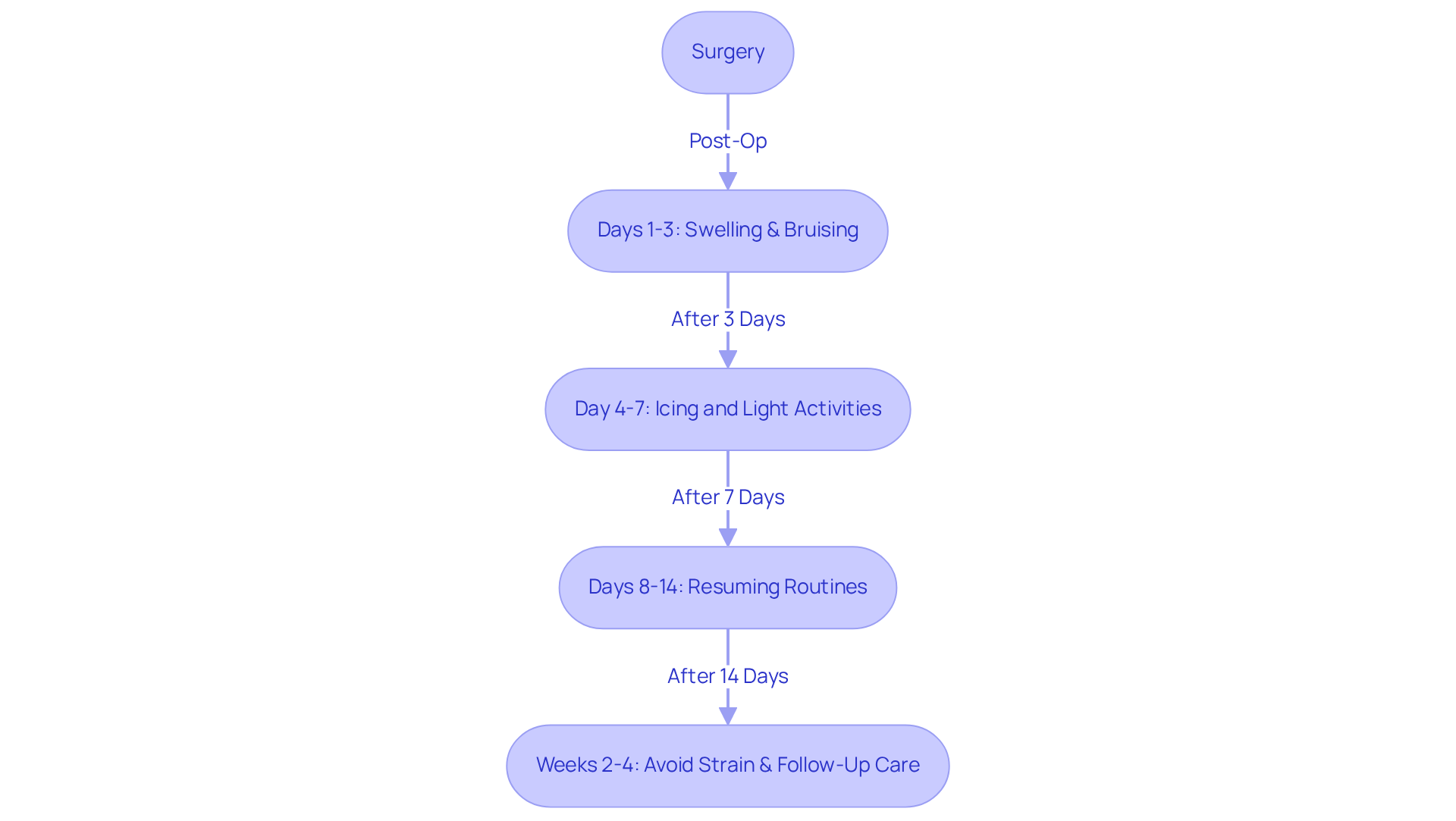
Understanding the Surgical Process: What to Expect
We understand that considering eye procedures can bring about many questions and concerns. It’s important to discuss the procedure thoroughly with your surgeon, including the various anesthesia options available for eye treatments. Dr. David A. Sherris notes that eyelid surgery before and after is a highly sought-after treatment, with over 325,000 Americans experiencing it in 2020. Many patients report only minor discomfort during the procedure, which is often regarded as one of the least painful cosmetic operations.
It’s common to feel uncertain about the specifics of eye enhancement procedures. These may involve careful incision placement and the extraction or repositioning of tissue to achieve the desired outcomes seen in eyelid surgery before and after. Typically, an lasts about 45 minutes to one hour, while a combined upper and lower blepharoplasty may take up to two hours.
During surgery, we want you to feel safe and cared for. Medical staff will closely monitor your vital signs and responsiveness to anesthesia, ensuring your comfort throughout the operation. This attentive monitoring is designed to help you feel secure during this important time.
After the procedure, you will be taken to a post-operative room where immediate care is provided. Patients are generally observed until they are stable and comfortable, facilitating a smooth transition from the surgical setting to recuperation. We are here to help you through this process and ensure you feel supported every step of the way.
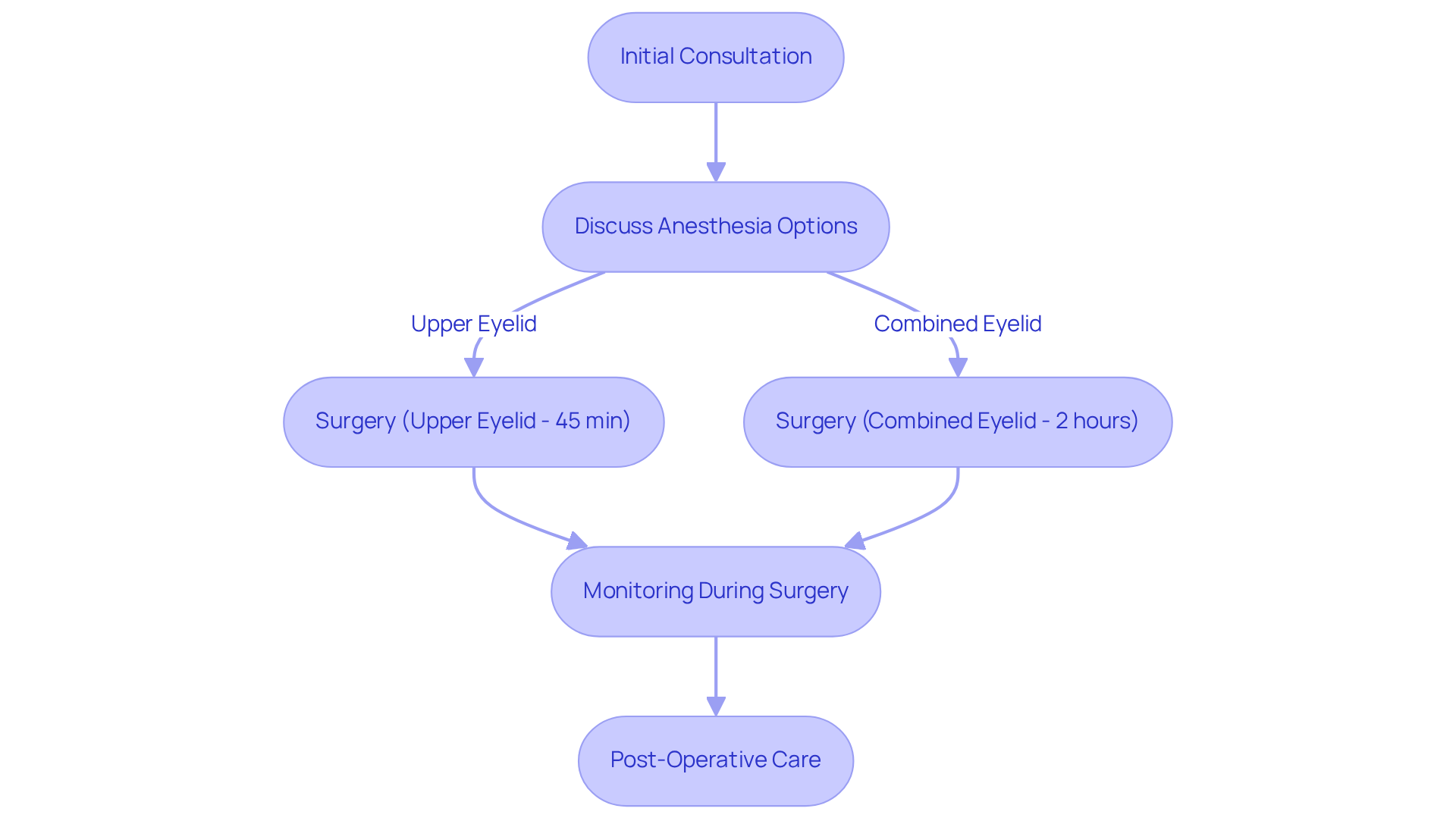
Lifestyle Adjustments: Preparing for Long-Term Results
Maintaining a healthy diet rich in vitamins A, C, and E is essential for supporting your skin health and understanding the results of eyelid surgery before and after. These vitamins play a crucial role in collagen production and tissue repair, which are vital during your recovery process, especially when considering eyelid surgery before and after.
We understand the importance of staying hydrated to promote overall health and skin elasticity. Proper hydration helps maintain blood consistency, supports circulation, and enhances nutrient delivery to healing tissues. We recommend aiming for at least 6-8 glasses (1.5-2 liters) of water daily to aid in your healing and reduce complications such as blood clots and infections. It’s common to feel the effects of dehydration, so be aware of signs like dry mouth, dark-colored urine, dizziness, and lack of energy, and take action to remain hydrated during your recuperation.
Protecting your eyes from UV exposure is also important. Wearing sunglasses outdoors helps prevent damage to the delicate skin around your eyes and , especially if you experience irritation from allergies or infections.
Additionally, we encourage you to avoid smoking and limit alcohol consumption, as both can hinder healing and affect skin quality. These habits may lead to complications, including increased inflammation and delayed wound healing. It’s also wise to steer clear of coffee and alcohol, as they can dehydrate you and hinder your recovery.
Scheduling regular eye exams is a proactive step in monitoring your eye health and addressing any emerging issues. Early detection of potential problems, such as conjunctivitis or dry eye disease, can significantly improve your outcomes and ensure long-term success. Remember, we are here to help you through this process, and your well-being is our priority.
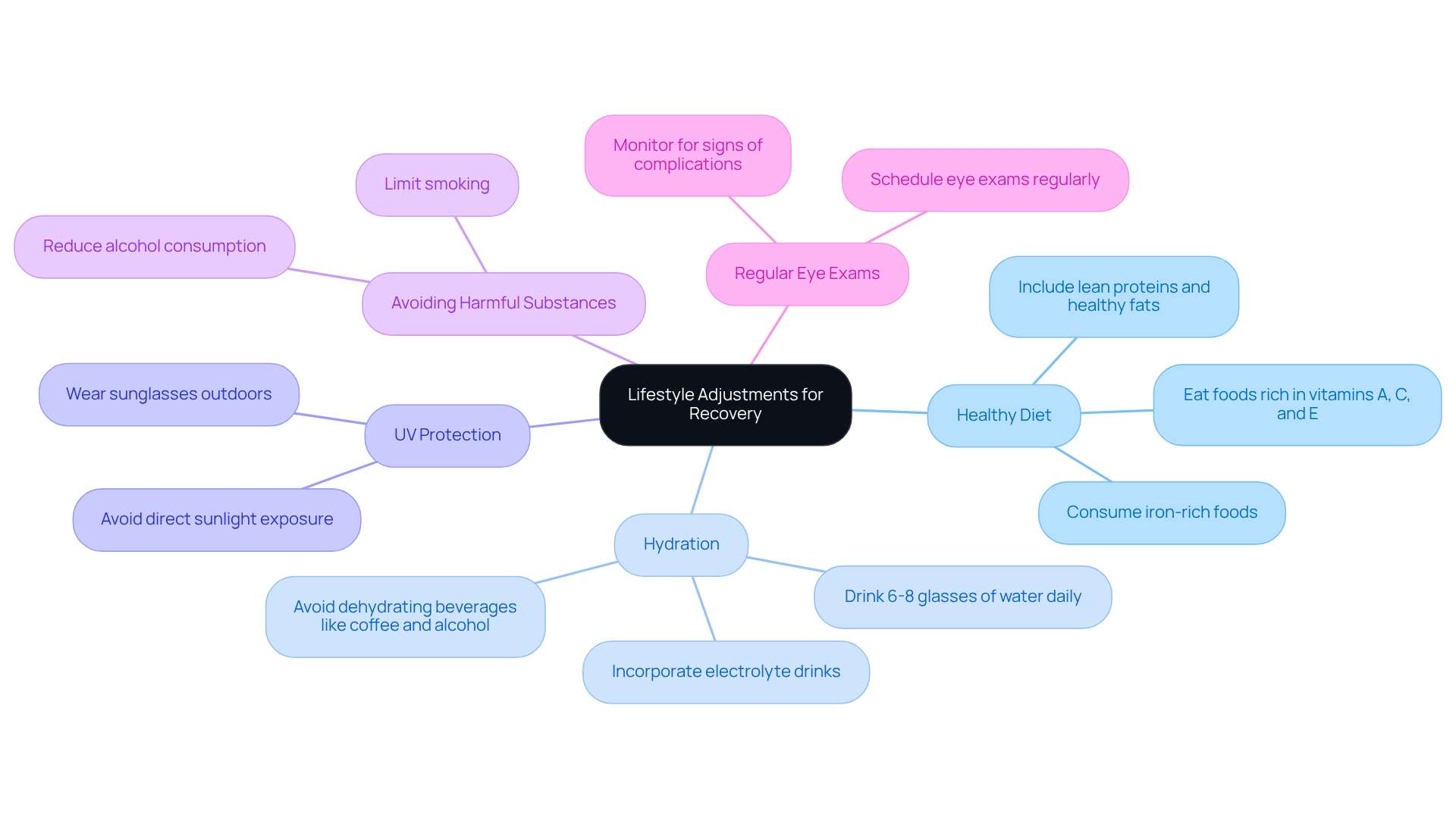
Conclusion
Eyelid surgery, or blepharoplasty, is not merely a cosmetic enhancement; it is a journey that requires thoughtful preparation and attentive post-operative care to achieve the rejuvenated look you desire. By following the outlined checklist, you can navigate the complexities of this procedure with confidence, ensuring a smoother experience from start to finish.
This article has detailed essential steps, from scheduling pre-operative consultations and arranging for post-surgery transportation to understanding recovery expectations and making necessary lifestyle adjustments. We understand that adhering to medical advice, managing post-operative symptoms, and maintaining a healthy lifestyle significantly contributes to the overall success of your surgery. Each of these components plays a crucial role in minimizing risks and enhancing recovery, ultimately leading to the best possible results.
In conclusion, the significance of thorough preparation and attentive care cannot be overstated when considering eyelid surgery. Embracing these guidelines not only helps in achieving optimal surgical outcomes but also fosters a sense of empowerment throughout your process. Taking proactive steps to ensure a successful recovery will pave the way for lasting results, allowing you to enjoy the benefits of your transformation for years to come.
Frequently Asked Questions
What should I do before eyelid surgery?
Schedule a pre-operative consultation to discuss your medical history and medications, arrange for someone to drive you home after surgery, follow your surgeon’s instructions regarding medication modifications, avoid smoking and alcohol for at least fourteen days, prepare your home for recovery with essential supplies, and ensure you have sufficient time off work for healing.
How can I prepare my home for recovery after eyelid surgery?
Create a comfortable resting area stocked with essential supplies such as ice packs and prescribed medications to help you feel secure during your recovery.
How long should I expect to take off work after eyelid surgery?
It is generally recommended to allow one to two weeks for healing to ensure a smooth recovery process.
What should I do if I have concerns before the surgery?
Engage in open discussions with your surgeon about any questions or concerns you may have to foster confidence and clarity regarding the procedure.
What are the essential post-operative care instructions after eyelid surgery?
Apply cold compresses to your eyes for the first 48 hours, take prescribed medications as directed, keep your head elevated while resting, avoid strenuous activities, and refrain from wearing makeup on your eyelids for at least two weeks.
How can I manage swelling after eyelid surgery?
Applying cold compresses for the first 48 hours can significantly reduce swelling and discomfort. It’s also important to keep your head elevated while resting to aid fluid drainage and minimize pressure on the surgical site.
When can I resume normal activities after eyelid surgery?
Most patients can resume driving and moving around without much difficulty after several days, but strenuous activities, bending down, or heavy lifting should be avoided for at least fourteen days.
What should I do if I notice unusual symptoms after surgery?
If you experience excessive swelling, bleeding, or changes in vision, report these symptoms to your surgeon immediately for prompt intervention to prevent complications.
Why is it important to attend follow-up appointments after eyelid surgery?
Attending follow-up appointments is crucial for monitoring your healing process and addressing any concerns to ensure that your recovery remains on track.






